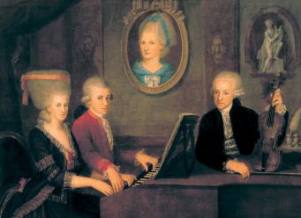Mozart: Piano Duets – Vol 1
Julian Perkins & Emma Abbate
Resonus RES10172. 68’04
 Mozart: Sonata in D, K381; Sonata in C, K521; Sonata in B-flat, K358, JC Bach: Sonata in A.
Mozart: Sonata in D, K381; Sonata in C, K521; Sonata in B-flat, K358, JC Bach: Sonata in A.
This is the first of two volumes of Mozart’s complete piano duets, played on original fortepianos by Julian Perkins & Emma Abbate. It was recorded in Finchcocks House, Kent, and was the last recording made their before the house was closed and much of Richard and Katrina Burnett’s important collection of early keyboard instruments was sold. These two pianos, together with another 12 instruments from the collection, remain within the Finchcocks Charity for Musical Education which will continue to sponsor research and training a new generation of early keyboard restorers, tuners and technicians.
Although Mozart’s piano duets are a little-known part of his compositional output, they are a genre that he returned to throughout his life. They stem from his childhood experience of playing duets at home with his sister Nannerl. There is also an advertised performance in 1765 at the Swan and Harp Tavern in Cornhill, London, where the siblings played ‘with four hands upon the same harpsichord’. A painting of the two rather older siblings playing can be found in the Mozart Residence in Salzburg (pictured).
 If you associate the sound of Mozart on period instruments as being delicate and tinkly, then the power of four hands might initially surprise you. The piano used for the Mozart is a Fritz grand piano from Vienna and dating from around 1815. With the rapid development in piano construction in the decades either side of 1800 it is arguably a little late for these Mozart Sonatas, which were composed between 1772 and 1787. Although it is certainly capable of delicate tone colours, it is the power and tonal depth that initially creates the biggest impression. There is very occasionally some slight noise from the mechanism, but no more than you would expect from a relatively close recording in an, albeit rather grand, domestic interior.
If you associate the sound of Mozart on period instruments as being delicate and tinkly, then the power of four hands might initially surprise you. The piano used for the Mozart is a Fritz grand piano from Vienna and dating from around 1815. With the rapid development in piano construction in the decades either side of 1800 it is arguably a little late for these Mozart Sonatas, which were composed between 1772 and 1787. Although it is certainly capable of delicate tone colours, it is the power and tonal depth that initially creates the biggest impression. There is very occasionally some slight noise from the mechanism, but no more than you would expect from a relatively close recording in an, albeit rather grand, domestic interior.
The Johann Christian Bach Sonata was published in 1778, and is played on a much smaller single-strung travelling square piano by Anton Walter & Son, made in Vienna around 1805 – again, perhaps a little late, but no matter. Mozart got to know JC Bach (the ‘London’ Bach), during his 1765 trip to London, and it has been suggested that the 8 year-old Mozart played keyboard duets with JCB whilst sitting on the older composer’s lap.
Julian Perkins & Emma Abbate play with a delightful sense of the often playful quality of these pieces, revelling in the power and vitality of the faster Italianate movements as
well as the gentler central slow movements, notably in the beautifully lyrical Adagio from the concluding Sonata in B-flat, played with impressive sensitivity. Their ability to play in perfect time together is exemplary – apart from the much richer sound of the pianos, it is difficult to appreciate that two people are playing, rather than just one. For an insight into the lesser-known side of Mozart’s playing and compositional life, this is thoroughly recommended. It is also a timely recognition of the work of Richard and Katrina Burnett over the past 45 years in creating such an important musical instrument museum at Finchcocks (pictured).
Further information and a link to the booklet can be found here.

2 thoughts on “Mozart: Piano Duets”